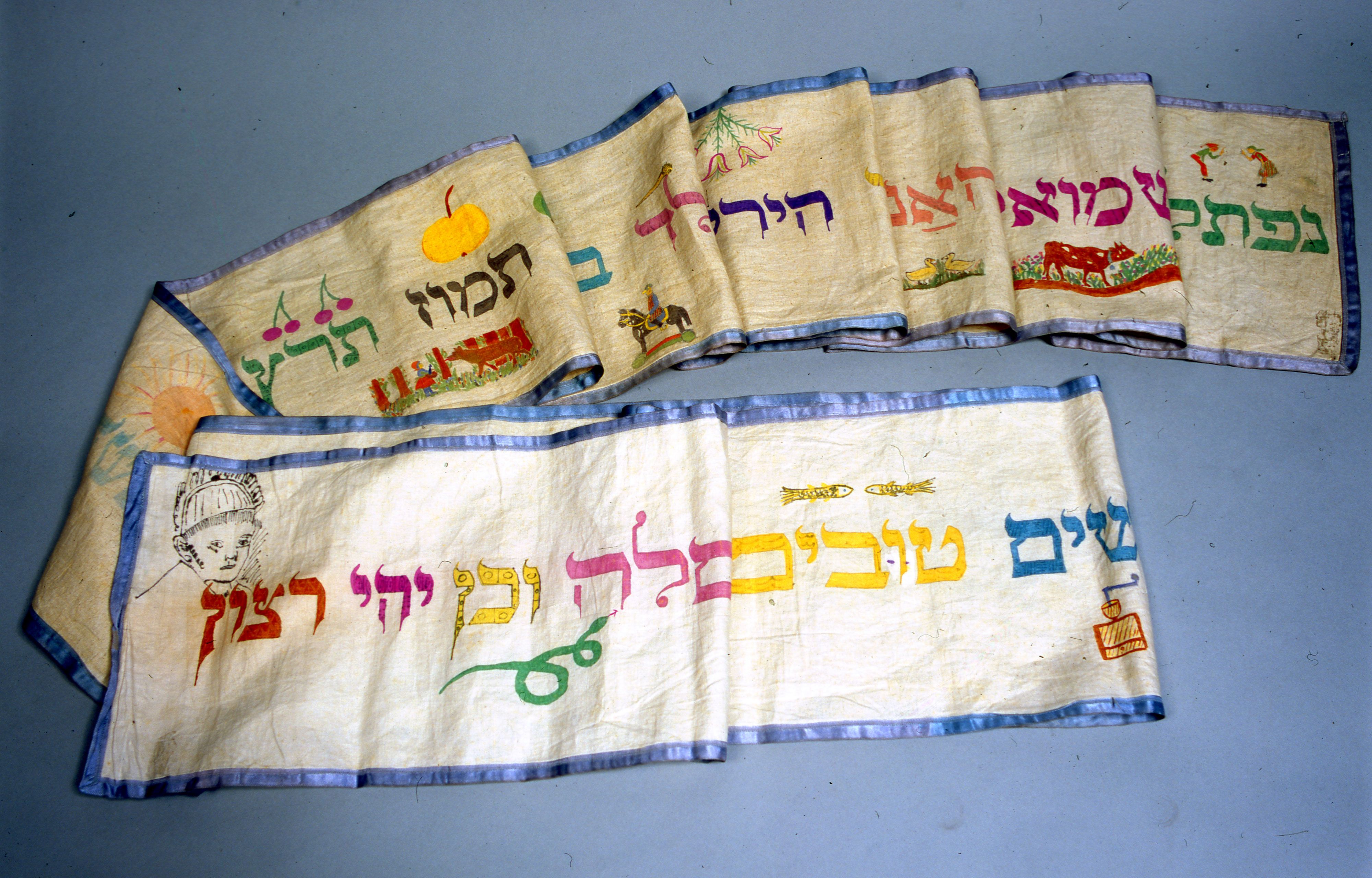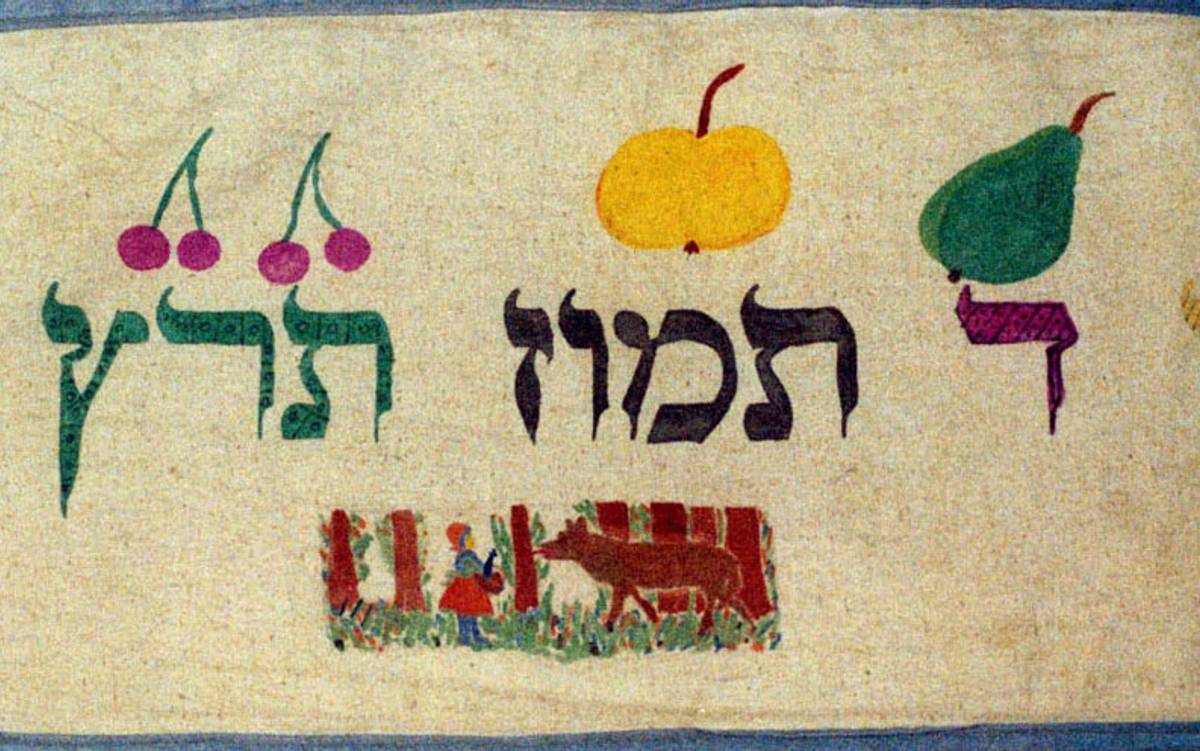A New Life for an Old Tradition
Wimpels have been used as ritual objects by German-speaking Jews for centuries, but these days in the U.S., the Torah binders have become part of new traditions in a wide variety of Jewish communities



Whether in Prague or New York City, Jerusalem or Chicago, collections of wimpels—Torah binders—can be found at Jewish museums worldwide. Some represent donations from private family collections; others are orphaned objects from Jewish restitution organizations such as the Jewish Cultural Reconstruction, which was established after WWII to distribute items looted by the Nazis from synagogues and private homes.
The wimpel—a strip of fabric created from an infant’s circumcision cloth for use as a Torah binder—is a centuries-old minhag (custom) that began in Bavaria and then spread to other parts of Germany and German-speaking communities in Austria, Switzerland, Luxembourg, Alsace, Holland, Czechoslovakia, and Denmark; German Jewish immigrants brought the custom to the U.S. and Israel. After the boy’s brit milah, a female relative would decorate this cloth with the child’s Hebrew name, Hebrew birth date, and Jewish symbols. Initially, the wimpel was brought to the synagogue to bind the Torah on the child’s first visit, symbolizing his binding to the Torah as a second covenant after his circumcision. Subsequently, the wimpel was used to bind the Torah during other lifecycle events, such as the boy’s bar mitzvah or aufruf.

The first mention of the wimpel custom is in the 1530 book Der gantze Jüdisch Glaub (The Whole of Jewish Belief), by the German Hebraist Antonius Margaritha, a convert to Christianity. As the son of a German rabbi, Margaritha knew Jewish customs well, although the book’s tone is antisemitic.
“The wimpel is important from an historical perspective,” explained Shalom Sabar, professor emeritus of Jewish art and folklore at the Hebrew University in Jerusalem. “Because it includes the Hebrew date of birth, it serves as a Jewish birth certificate.” In the past, he says, most Jewish communities did not record a child’s exact birthdate, although the mohel and the boy’s father would write the circumcision date in their prayer books.
The earliest surviving wimpels are simple embroidered pieces, such as this 1611 Torah binder from the William Gross Family Collection. By the mid-18th century, they became more elaborate, were sometimes painted, and included symbols such as the boy’s zodiac sign or illustrations of a wedding canopy with the phrase from the brit milah liturgy (with slight variations by community): “May the Lord raise him to the Torah, to the chuppah, and to a life of good deeds,” reads an 18th-century German wimpel from the Stieglitz Collection. During the 19th-century Emancipation period in Europe, some wimpels included the child’s nickname or secular first name in addition to his Hebrew name. By the 20th century, some wimpels—such as those by Reuben Eschwege, an artist, mohel, and cantor who emigrated from Germany to the U.S. in 1939—featured children’s motifs alongside traditional Jewish objects.
The wimpel is not just a museum piece. K’hal Adath Jeshurun (“KAJ” or the “Breuer Shul”) in the Washington Heights neighborhood of Upper Manhattan (once a German-Jewish enclave known as Frankfurt on the Hudson) still maintains the minhag for ritual use, in traditional ways. This Orthodox community—founded by German Jewish emigrés in the 1930s—provides its congregants with linen cloth to use at the baby’s brit milah and to create a wimpel for later lifecycle events.
The wimpel has also spread to unexpected places in the U.S. in recent years. An article by Sabra Wakefield Morton, published in 1976 in the Second Jewish Catalog, introduced the custom to a broad audience outside of the German Jewish tradition. Since the late 20th century, many types of Jewish communities have been keeping the wimpel custom alive, but in new ways.
The wimpel has now become a tool to teach children about Jewish lifecycle ceremonies and their families’ histories—including families who are not necessarily of Germanic descent—while strengthening intergenerational bonds. The wimpel today wraps the Torah on the occasion of significant Jewish lifecycle events celebrated by females and males alike, including upsherin (a boy’s first haircut at age 3), consecration or the beginning of a child’s formal Jewish education, the bar and bat mitzvah, and the aufruf. The wimpels they use don’t always look like the ones in the museums—and they are created from brand-new fabric rather than a circumcision cloth: Today’s 21st-century wimpels are as likely to include images of Harry Potter and soccer balls as Jewish symbols such as the Etz Chayim (Tree of Life) and Star of David.
At Congregation Ohev Shalom, a Conservative synagogue in Maitland, Florida, the wimpel is part of a more than 20-year-old Simchat Torah tradition. Each year, first-grade religious school students receive an 8-inch-high Torah during their consecration ceremony, which takes place under a chuppah covered with each child’s handmade wimpel. “The wimpel symbolizes something that can be carried through one’s Jewish life, as can Torah,” said Amy Geboff, the congregation’s director of youth and family education.
For Miriam Shazeer, the wimpel represents a powerful intergenerational bond. The Massachusetts grandmother created three wimpels in honor of each of her three grandsons’ first haircut at age 3. Each Torah binder is unique, with personally meaningful symbols; for instance, the wimpel of her grandson, who will be bar mitzvahed this October, includes shofars and pomegranates, symbolizing his birth a few days before Rosh Hashanah. “It was truly a labor of love, although a lot of work,” said Shazeer, who learned about the tradition from her daughter. “It connects us and hopefully it will be an heirloom, used at their weddings and they will continue the custom for their own children.”
“There is a way to take a ritual item, bring it into the present, and make it not only important but also part of an individual child’s Jewish history,” said Rabbi Renée Edelman of Temple Sha’arey Shalom, a Springfield, New Jersey, Reform congregation that owns a collection of framed wimpels from Europe. Now, during a fourth-grade program, each family works to design an original wimpel—with the child’s Hebrew name, blessings, and meaningful symbols—for use at the bar/bat mitzvah.
Inspired by the wimpels he had seen in European museums, Rabbi Sid Helbraun created the Wimpel Project six years ago at Temple Beth-El, a 150-year-old Reform synagogue in Northbrook, Illinois. “It seemed to me a beautiful custom of taking that swaddling cloth to bind the Torah and take us from the earth cycle up to the bimah for b’nei mitzvah celebrations,” he explained. “Judaism isn’t that Sinai moment of reading the Torah. It is part of the cycle of our life and how we live each day.”
Temple Beth-El holds an annual wimpel-making workshop for second-grade families and new community members with older children. Participants learn how to make a wimpel, as well as about Jewish life ceremonies and Hebrew names. “People love telling their children the story of their Hebrew name, who they are named for, and their memories of this person whom they hope the child will emulate,” said Rabbi Ari Moffic, the synagogue’s director of congregational learning. “Jewish ritual and ceremonial objects are very important for our Jewish practice … Creating Judaica in the home, this is our cultural identity.”
At Temple Beth-El, families present wimpels during the second-grade consecration service, typically when Parashat Yitro (the story of receiving the Torah at Sinai) is read. The wimpel is stored until the bar or bat mitzvah when it is used to wrap the Torah—an experience that was meaningful for the family of Josh Dapin, who was bar mitzvahed this past April. “The rabbi showed it to the congregation and shared a few words about the wimpel,” said his mother, Mindy Dapin, who placed the wimpel in a keepsake box as a treasured family heirloom. “It was a nice family memory and added a special element to the day.”
Lonna Picker introduced wimpels in the mid-1980s to Temple Torat Yisrael, a Conservative synagogue in Cranston, Rhode Island (currently in East Greenwich), where she was director of education. “I had started reading about wimpels and thought it would be the most incredible project to bring to my school,” said Picker. Her goal was to create an inclusive family education program for its diverse population of same-sex couples and single-parent, interfaith, and racially mixed families. “The question for me was how to do programming that meets those needs. Every family has a history, a past, and goals for the future … My goal was always to meet people where they are,” she told Tablet. “It’s important for kids to have something tangible that they can use in their family celebrations. These wimpels are a connection that is meaningful and tells their family history.”
Together with Torat Yisrael’s faculty, Picker created a third-grade Hebrew school project—“Wimpels: A Time to Blossom, A Time to Bind”—a wimpel-making workshop where families shared their histories, discussed their children’s Hebrew names, and learned how to create wimpels. Eventually, she presented wimpel workshops at local and national Jewish education meetings and conferences, which influenced other American synagogues to hop on the wimpel bandwagon, a tradition that continues to this day.
At Temple Israel of Natick, a Conservative synagogue in suburban Boston, wimpels have been part of the fabric of family education for more than three decades. Thirty-one years ago, Rabbi Emeritus Dan Liben introduced wimpel-making for bet (second grade) consecration—a custom he had learned from Picker and had used in family education at his previous congregation, Temple Emanu-El of Providence, Rhode Island.
“It helped young families to see a sense of continuity and flow that put them in the context of a community during the communal moment when the child finished the bet class and had learned the Hebrew alphabet,” explained Liben. “It also helped people create a relationship to Torah and wrap around the Torah scroll in a personal way.”
Liben also aspired to create a new 20th-century New England folk art as a window into the lives of suburban Boston Jewry. “I hoped that someone would gather them and think about this period in American Jewish history just as we look back at these wimpels from Germany.”
Since then, hundreds of Temple Israel’s b’nei mitzvah have bound the Torah with their wimpels; some have also used them at their aufrufs. “I have a recollection of the first time that a family was able to use the wimpel from their child’s bar mitzvah at their child’s aufruf,” said Liben. “We felt that it was the mark of having gone through life as a community.”
The wimpel is a powerful and distinct Jewish ritual item that is both personal and communal, says Gabriel Goldstein, interim director and chief curator at the Yeshiva University Museum whose wimpel collection includes those donated by Congregation Shaare Hatikvah in Washington Heights and the Jewish Cultural Reconstruction. “It is a folk tradition imbued with covenantal and religious purpose. It’s also an oxymoron because it is both profane and sacred, i.e., a child’s diaper that is physical and spiritual. I find it meaningful, powerful, and really intriguing.”
Centuries ago German Jews may not have imagined how the wimpel would adapt to contemporary American Jewish life, including binding the Torah during a bat mitzvah. However, this shift in focus is important because it keeps a beautiful minhag alive, particularly after the Holocaust when many wimpels were destroyed. “It’s nice the custom is revived and is changing in accordance with changes in society,” emphasized Sabar.
Paula Jacobs is a writer in the Boston area.